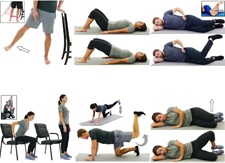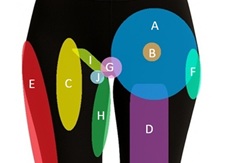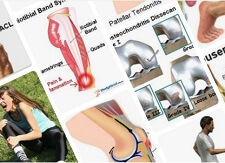- Home
- Hip Pain Diagnosis
- Hip Bursitis
- Trochanteric Bursitis
Trochanteric Bursitis
Written By: Chloe Wilson, BSc(Hons) Physiotherapy
Reviewed by: KPE Medical Review Board
Trochanteric bursitis is a common cause of outer hip pain. It occurs when the bursa, a fluid-filled sac that cushions the hip joint, becomes inflamed.
This inflammation can lead to pain, tenderness, and difficulty with activities like walking, climbing stairs, or lying on the affected side.
While it can affect anyone, trochanteric bursitis is more common in athletes, women and people with issues like tight muscles or leg length discrepancies. Fortunately, most cases can be managed with simple treatments like rest, physical therapy, and anti-inflammatory medications.

In this article, we'll explore the causes, symptoms, treatment options, and prevention tips to help you manage or avoid Trochanteric Bursitis.
What Is Trochanteric Bursitis?
Trochanteric bursitis is when there is irritation and inflammation on the bursa found on the outer hip.

On the outer, upper edge of the hip bone (femur) is a large bony prominence known as the greater trochanter.
A number of the hip and thigh muscles attach onto the greater trochanter, including the glutes muscles and the iliotibial band.
Sitting directly over the greater trochanter bony lump is a bursa – a small fluid-filled sac known as the trochanteric bursa. It acts like a cushion to reduce friction between the greater trochanter and the overlying muscles and tendons.
If there is too much pressure or repetitive friction placed on the trochanteric bursa, then the bursa will begin to swell and thicken, known as trochanteric bursitis.
Trochanteric bursitis is part of a broader group of conditions known as Greater Trochanteric Pain Syndrome (GTPS), which encompasses other issues like tendonitis and gluteal tendinopathy that also contribute to pain around the greater trochanter. It is the most common type of hip bursitis and the most common cause of outer hip pain.
What Causes Trochanteric Bursitis?
Trochanteric bursitis can develop from various causes, ranging from simple overuse injuries to biomechanical issues or underlying medical conditions. Some of the most common causes of greater trochanteric bursitis include:
- Repetitive Stress and Overuse: Repetitive movements, especially those involving the hip, can irritate the bursa over time. High-impact activities such as running, cycling, and stair climbing are particularly associated with trochanteric bursitis. These activities put repeated strain on the hip joint and the surrounding muscles, causing friction between the bursa and the tendons.
- Trauma or Direct Injury: A direct blow to the side of the hip, such as from a fall or bumping into something, can lead to inflammation of the bursa. Even if the injury seems minor, the trauma can cause the bursa to swell, leading to pain and discomfort.
- Sudden Increase in Activity Levels: especially when starting a new exercise regimen or significantly ramping up the intensity or duration of workouts, is a common cause of trochanteric bursitis. For example, going from a sedentary lifestyle to intense running, hiking, or cycling without gradually building up your endurance can place overwhelming stress on the hip bursa.
- Tight Iliotibial Band: The iliotibial band (IT band) is a thick band of connective tissue that runs along the outside of the thigh, from the pelvis down to the shin. If the IT band becomes tight or inflamed, it can rub against the trochanteric bursa, leading to irritation. IT band syndrome is a common issue among runners and athletes and is often associated with trochanteric bursitis.
- Biomechanical Problems: Structural issues in the body, such as scoliosis, leg length discrepancies or abnormal gait patterns, can place extra stress on the hip joint and the bursa. For example, if one leg is shorter than the other, it can cause uneven pressure on the hips during walking or running, increasing the risk of bursitis.
- Arthritis and Degenerative Conditions: People with knee arthritis, particularly osteoarthritis, gout or rheumatoid arthritis, are more prone to developing trochanteric bursitis. These conditions cause inflammation in the joints and bone spurs, which can lead to additional stress on the bursa.
- Other Factors: Obesity, muscle weakness and tightness, poor core strength, hormonal factors and being female all increase your risk of developing trochanteric bursitis.
Around 90% of people with trochanteric bursitis also suffer from gluteal tendinopathy, where there is irritation of the gluteal tendons, which run directly over the trochanteric bursa.
Trochanteric Bursitis Symptoms
The symptoms of trochanteric bursitis can vary from person to person, but typical symptoms include:
- Lateral Hip Pain: The most prominent trochanteric bursitis symptom is outer hip pain, usually located directly over the greater trochanter. This pain may start as a dull ache but can become sharp, particularly during certain activities or movements.
- Tenderness to Touch: The area over the greater trochanter may feel tender or sore to the touch. This is especially noticeable when lying on the affected side, making it uncomfortable to sleep on that side of your body.
- Pain with Movement: Hip bursitis pain often increases with activities like walking, running, climbing stairs, or getting in and out of a car. You may also feel discomfort when getting up after prolonged sitting or inactivity e.g. first thing in the morning
- Pain In Certain Positions: Sitting with your legs crossed, or standing with most of your weight on one leg are often painful with trochanteric bursitis
- Swelling and Warmth: In some cases, the outer hip may become swollen or warm to the touch, usually if there is septic bursitis. While these symptoms are not always present, they can occur in more severe cases.
- Radiating Pain: Sometimes the pain can radiate down the side of the thigh towards the knee and may cause lateral knee pain. Although less common, some people may mistake this for sciatica or other types of hip-related pain.
- Stiffness: You may notice stiffness and reduced hip range of motion, especially after prolonged periods of rest or in the morning upon waking. This stiffness can make it difficult to move the hip freely without discomfort until you have loosened up.
Trochanteric bursitis symptoms will vary from person to person, the most common being outer hip pain that gets worse with activity, after prolonged rest or when there is pressure on the bursa.
Diagnosing Trochanteric Bursitis
Diagnosing trochanteric bursitis typically involves a combination of patient history, clinical evaluation, and sometimes imaging studies to confirm the diagnosis and rule out other potential causes of hip pain.
1. Medical History
When diagnosing suspected trochanteric bursitis, your healthcare provider will start by asking about your symptoms, lifestyle, and medical history.
They’ll want to know when the pain started, what activities make it worse, and if you’ve had any recent injuries or overuse of the hip. They may also ask about underlying conditions like arthritis or leg length discrepancies that could contribute to your symptoms.
2. Physical Examination

During the physical exam, the doctor will assess your hip movement and strength as well as pressing on the greater trochanter to determine if it's tender.
They may also ask you to perform certain movements, like standing on one leg or walking, to see how the hip responds.
This can help to differentiate trochanteric bursitis from other hip conditions, such as hip osteoarthritis, ischial bursitis, hip impingement, gluteal tendinopathy or snapping hip syndrome.
A useful test for trochanteric bursitis is resisted hip abduction – your doctor will ask you to move your leg out sideways while they resist the movement with their hand. Pain over the greater trochanter as soon as they STOP resisting the movement (rather than while applying resistance resistance) is a classic sign of hip bursitis.
3. Imaging Tests
If the diagnosis is unclear or if the doctor suspects other conditions are contributing to your pain, they may order imaging tests like an X-ray or MRI.
X-rays can help rule out bone-related conditions such as arthritis or hip impingement, while MRIs are more detailed and can show inflammation in the soft tissues, including the bursa and surrounding tendons.
Trochanteric Bursitis Treatment
The good news is that trochanteric bursitis is highly treatable, and most people can manage their symptoms with conservative measures.
Trochanteric bursitis treatment is aimed at reducing pain and inflammation, improving mobility, and addressing any underlying causes of the condition.
#CommissionsEarned from Amazon on qualifying purchases
1. Rest and Activity Modification
The first step in treating trochanteric bursitis is to rest, avoiding activities that aggravate the pain. This includes high-impact activities like running, sports, or prolonged walking.
Resting the affected hip allows the inflammation to subside, which is critical to the healing process.
2. Ice and Heat Therapy

Applying ice packs to the affected area can help reduce any inflammation and numb the pain as part of your trochanteric bursitis treatment.
Ice is especially useful in the acute phase of the condition. Apply ice for 15-20 minutes several times a day.
Once the inflammation decreases, heat therapy can be beneficial to relax tight muscles around the hip and improve blood flow to the area.
3. Medication
Over-the-counter NSAIDs like ibuprofen/Advil or naproxen can help reduce hip bursitis pain and inflammation. Be sure to follow the recommended dosage and consult with your doctor, especially if you have any underlying medical conditions that might be affected by these medications.
4. Physical Therapy

Physical therapy is a cornerstone of trochanteric bursitis treatment.
A physical therapist will design a customized exercise program to stretch and strengthen the muscles around the hip, particularly the glutes, hip abductors, and the IT band.
Trochanteric bursitis exercises will help reduce pressure on the bursa and improves overall hip stability.
Key trochanteric bursitis exercises may include:
- Stretches: to reduce pressure/tension on the bursa. Typically focusing on ITB stretches, and hip/glute stretches
- Strengthening Exercises: to support the hip joint. Typically focusing on glute strengthening exercises
Your physical therapist may also recommend a course of electrotherapy such as ultrasound (US) or pulsed shortwave diathermy (PSWD) to reduce pain and swelling and promote healing.
5. Corticosteroid Injections

If conservative trochanteric bursitis treatments do not provide relief, a corticosteroid injection into the bursa can be an effective option.
Steroid injections reduce inflammation and can offer pain relief for several weeks to months.
While this isn’t a long-term solution, it can be helpful in breaking the pain cycle so you can start trochanteric bursitis exercises.
6. Assistive Devices
During flare-ups or severe cases, using assistive devices like a cane or crutch can help take weight off the affected hip. This offloading can prevent further irritation of the bursa and allow for faster recovery.
7. Surgery For Trochanteric Bursitis
In very rare cases of trochanteric bursitis where conservative treatments fail and the pain remains debilitating, surgical intervention may be considered. This typically involves a bursectomy, where the inflamed bursa is surgically removed. The procedure is minimally invasive, often done arthroscopically, and patients typically recover well.
Another type of surgery for trochanteric bursitis that may be considered is IT band release, where tension on the iliotibial band is surgically reduced to relieve pressure on the bursa. Surgery is generally considered a last resort after all other treatments have been exhausted.
It’s important to note that while surgery for trochanteric bursitis can be successful, it’s not usually necessary for most people. Recovery from surgery involves a period of rehabilitation, including physical therapy, to restore strength and function to the hip.
Trochanteric Bursitis FAQs
What Is Trochanteric Bursitis?
What Is Trochanteric Bursitis?
Trochanteric bursitis is the inflammation of the bursa (a fluid-filled sac) located over the greater trochanter, the bony prominence on the outer hip. This type of hip bursitis causes pain and tenderness on the outside of the hip, particularly during leg movement or when lying on the affected side.
Common causes of trochanteric bursitis include repetitive stress from activities like running or cycling, trauma to the hip, tightness in the iliotibial (IT) band, a sudden increase in activity levels, biomechanical issues like leg length discrepancies, arthritis, and spinal problems such as scoliosis.
What Are The Symptoms Of Trochanteric Bursitis?
What Are The Symptoms Of Trochanteric Bursitis?
The main trochanteric bursitis symptoms include outer hip pain, tenderness over the greater trochanter, increased pain with activity, difficulty lying on the affected side, and sometimes radiating pain down the thigh with lateral knee pain. Swelling and warmth around the hip are less common but may occur in more severe cases.
How Is Trochanteric Bursitis Treated?
How Is Trochanteric Bursitis Treated?
Trochanteric bursitis treatment typically involves rest, ice, non-steroidal anti-inflammatory drugs (NSAIDs), physical therapy, trochanteric bursitis exercises to strengthen the hip and stretch tight muscles, and sometimes corticosteroid injections. In rare cases, surgery may be necessary if conservative treatments don’t work.
How Long Does It Take To Recover From Trochanteric Bursitis?
How Long Does It Take To Recover From Trochanteric Bursitis?
Recovery time with trochanteric bursitis varies depending on the severity of the condition and how well you follow the treatment plan.
Most people recover within 6 weeks to 3 months with conservative treatments like rest, physical therapy, and anti-inflammatories, but there may be flare-ups along the way. Severe cases may take longer, especially if there's an underlying issue like arthritis, and surgery may require additional recovery time.
Does Trochanteric Bursitis Hurt All Of The Time?
Does Trochanteric Bursitis Hurt All Of The Time?
Trochanteric bursitis does not usually hurt all of the time. Pain is typically most noticeable during specific activities, such as walking, climbing stairs, or lying on the affected side. The pain can also flare up during prolonged periods of activity or after overuse. With rest and proper treatment, the pain can subside, although chronic cases may have more persistent discomfort.
Can Trochanteric Bursitis Heal On Its Own?
Can Trochanteric Bursitis Heal On Its Own?
Yes, with proper rest and treatment, most cases of trochanteric bursitis improve within a few weeks to months. However, continuing activities that cause irritation without treatment can prolong healing or worsen the condition.
How Can I Prevent Trochanteric Bursitis From Recurring?
How Can I Prevent Trochanteric Bursitis From Recurring?
To prevent recurrence, focus on maintaining strong hip and gluteal muscles with hip strengthening exercises, stretching regularly (especially the IT band), gradually increasing activity levels, avoiding overuse, and addressing any underlying biomechanical issues like leg length discrepancies or improper gait.
Is Surgery Ever Required For Trochanteric Bursitis?
Is Surgery Ever Required For Trochanteric Bursitis?
Trochanteric bursitis surgery is rarely needed and is usually considered a last resort. In severe or chronic cases, surgery to remove the inflamed bursa (bursectomy) or release tension in the IT band may be performed if conservative treatments don’t provide relief.
Are There Foods And Drinks I Should Avoid With Trochanteric Bursitis?
Are There Foods And Drinks I Should Avoid With Trochanteric Bursitis?
Yes, certain foods and drinks can promote inflammation in the body and may worsen symptoms of hip bursitis. Foods to avoid include:
- Sugary foods and drinks: Refined sugars in candy, sodas, and baked goods can trigger inflammation.
- Processed and fried foods: These often contain unhealthy fats that promote inflammation.
- Excessive caffeine: Too much caffeine may increase inflammation and muscle tension in sensitive individuals.
- Alcohol: Excessive alcohol can increase inflammatory markers and contribute to dehydration.
- Red and processed meats: These can raise inflammatory levels in the body.
Opt for an anti-inflammatory diet rich in vegetables, fruits, whole grains, lean proteins, and healthy fats like olive oil.
Summary
Trochanteric bursitis is caused by irritation and inflammation of the trochanteric bursa on the outer side of the hip.
Repetitive stress or overuse, muscle weakness and tightness, hip trauma, biomechanical issues and sudden increases in activity levels are common causes of hip trochanteric bursitis.
The most common symptom of trochanteric bursitis is pain over the outer hip that gets worse with activity or after prolonged rest. In most cases there is a dull aching pain but there may be incidents of sharp pain in the hip. It is often associated with gluteal tendinopathy.
There are two other types of hip bursitis. If the pain is more localised underneath the buttocks over the sitting bones, it is more likely to be ischial bursitis, whereas if the pain is in the front of the hip, it is likely to be iliopsoas bursitis.
Trochanteric bursitis of the hip will usually settle down within 3-6 months with a combination of rest, physical therapy, exercises, and in some cases steroid injections or surgery.
Pain may refer down the outer thigh resulting in lateral knee pain. You may also be interested in the following articles:
- Outer Hip Pain
- Top Of Thigh Pain
- Front Hip Pain
- Hip Tendonitis
- Femoracetabular Impingement
- Knee Bursitis
- Glute Strengthening Exercises
Related Articles
Hip Strengthening
September 24, 2025
Hip Pain Diagnosis
September 16, 2025
Knee Pain Diagnosis
March 27, 2025
Medical & Scientific References
- Hip Bursitis. American Academy of Orthopedic Surgeons
- Greater Trochanteric Pain Syndrome (Greater Trochanteric Bursitis). StatPeals Publishing
- The management of greater trochanteric pain syndrome: A systematic literature review. Journal Of Orthopedics
- Trochanteric Bursitis. Medscape
Last Updated: September 17th, 2025
Next Review Due: September 17th, 2027





